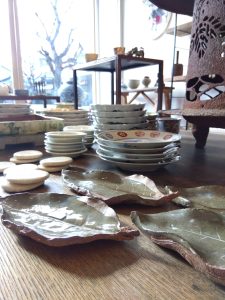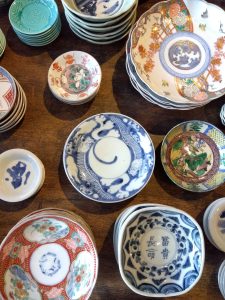器にもいろいろありまして…(愛知県名古屋市千種区姫池通 骨董品買取 古美術風光舎)
2024.03.29
みなさまこんにちは、スタッフTでございます。
名古屋も昨日ようやく開花宣言が出ました。朝からの雨も上がり、室内より外の方が暖かく感じるほどです。蕾も膨らみ、桜の木全体がピンク色になってきたような気がいたします。

さて、来月4月5,6,7日の「器と骨董展」開催にあたり、準備を進めております。
様々な器を手に取りながら、先日のブログで、傘は昔から形が変わらないと呟いたけれど、器もそうかもしれないなと思いながら作業しております。
日本の食生活に合わせて生まれた、様々なかたちの器。
和食器は海外の器とは比べ物にならないほど、形状のバリエーションがあります。それぞれの由来や違いを知れば、うつわ選びがさらに楽しくなるかもしれません。
どのかたちの名称も明確な決まりは無いようですので、メーカーやつくり手によって、同じようなかたちや用途でも違う名称の場合がありますが、一般的な種類として「碗」「茶器」「酒器」「蕎麦猪口」「鉢」「蓋物」「皿」などがあります。
今日は風光舎にも比較的多くの数がある「皿」について少し調べてみましたので、お付き合いください。
主に主菜・副菜などを盛り付けるための平ら、または浅い器。
洋食器の「プレート」にあたります。大きさによって、豆皿(手塩皿)・小皿・中皿・大皿などに呼び方が分かれます。また、形によって呼び方も変わります。
「丸皿」正円の皿。皿のなかでも定番のかたちで、幅広い用途に使えます。ちなみに、正円ではなく楕円形(オーバル)の皿は「楕円皿」と呼びます。
「角皿」正方形や長方形、八角形など、角型の皿。横長のものは特徴的な形状の料理を盛るときには欠かせず、特に焼き魚にぴったり。
「縁付き皿」縁の部分が一段立ち上がっている皿。洋食器では「リム皿」と呼びます。
「深皿」縁が少し立ち上がっていて、深さのある皿。
鉢ほどの深さはありませんが、多少の汁物も受け止めてくれるので、煮物などをよそうときに便利です。
「縁高皿」中央が平らで、縁が高くなっている皿。
料理が盛りやすい形状です。ワンプレートで様々な料理を盛り付けるときにもおすすめです。
「膾(なます)皿」生肉や魚、野菜を細かく刻み、酢であえた“なます”を盛るために、江戸時代に生まれた、少し深さのある5寸前後の皿。
「皿」だけでこんなにも呼び方がたくさんあるのは日本ならではな気もいたします。
そして、器選びの重要なポイントの一つである大きさ。和食器ではかたち、深さ等に関わらず、主に丸皿の場合、大きさを「寸(または号)」で表します。
現代ではあまりなじみのない「寸」という単位は、昔から使われている尺貫法の単位で、人の体を使って大きさ(長さ)を表した単位です。
1寸は約3.03cm。
これは親指をあてたくらいの長さで、1尺の1/10になります。ちなみに1尺は30.303cm。指先から肘までくらいの長さでしょうか。
また、大きさによって、豆皿(手塩皿)・小皿・中皿・大皿などに呼び方が分かれます。
私のようにどれを買ったらいいのか分からない(笑)という人は、まずは、メイン皿として7寸皿、取り皿として5寸皿を買い足すのが良いようです。そこから、豆皿を増やしていく、7寸と5寸の間の6寸皿を買い足す、丸ではない角皿や、縁が華やかな輪花皿を買うなどと増やしていくのが良いようです。
財布の紐を締めたいところですが、たくさんの可愛いお皿を眺めていると危険な気がしてまいりましたので、今日はこの辺りで終わりとさせてください。
ではでは、また。

Hello everyone, this is Staff T.
Yesterday, Nagoya was finally declared to be in full bloom. The morning rain has stopped and it feels warmer outside than inside. The buds are swelling and the entire cherry tree seems to be turning pink.
We are now preparing for the “Vessels and Antiques Exhibition” to be held on April 5, 6, and 7 next month.
As I hold a variety of vessels in my hands, I am thinking about what I said in my blog the other day about umbrellas not changing their shape since ancient times, and I think that the same may be true of tableware.
Various shapes of dishes have been created to suit the Japanese diet.
Japanese tableware has a much wider variety of shapes than foreign tableware. Knowing the origin and differences between them may make your choice of tableware even more enjoyable.
There seems to be no clear rule for the name of each shape, so different manufacturers and makers may use different names for similar shapes and uses.
Today, I have done a little research on the relatively large number of “plates,” so please bear with me.
A flat or shallow dish used mainly for serving main and side dishes.
It corresponds to a “plate” of Western tableware. Depending on the size, there are different types of plates, such as mame-dasai (salt dishes), small plates, medium plates, and large plates. The terminology also varies depending on the shape.
Round plate” is a plate with a regular circle. It is a standard shape among plates and can be used for a wide range of purposes. Oval-shaped plates are called “oval plates.
KAKU-DARA” square, rectangular, octagonal, or other square-shaped dishes. Horizontal dishes are indispensable for serving dishes with distinctive shapes, and are especially suitable for grilled fish.
Rimmed plate” is a plate with a raised rim. In Western tableware, it is called a “rimmed plate.
Deep dish” A deep dish with a slightly raised rim.
It is not as deep as a bowl, but it can hold some soup, so it is useful for serving simmered dishes.
Rim-taka-dish” A dish with a flat center and a high rim.
It is a shape that makes it easy to serve food. It is recommended for serving a variety of dishes on a single plate.
Namasu Dish” is a slightly deep dish of around 5″ in diameter, created in the Edo period to serve “Namasu”, a dish of finely chopped raw meat, fish, or vegetables with vinegar.
There are so many different names for the word “plate” alone.
Size is one of the most important factors in selecting dishes. In Japanese tableware, regardless of shape or depth, the size of a round dish is expressed as “sun (or no.)”.
The “sun” unit, which is not so familiar to us today, is a unit of the shaku-kan-bo system, which has been used since ancient times to express size (length) using the human body.
One “sun” is approximately 3.03 cm.
This is about the length of a thumb, which is 1/10 of 1 shaku. Incidentally, 1 shaku is 30.303 cm, or about the length from the tip of a finger to the elbow.
Depending on the size, there are different types of plates, such as mame-dara (salt dish), small dish, medium dish, and large dish.
If you are like me and don’t know which one to buy (laugh), it is a good idea to start by buying a 7″ plate as a main dish and a 5″ plate as a side dish. From there, you can increase the number of bean dishes, buy more 6″ plates between the 7″ and 5″ plates, buy square plates that are not round, or buy rinka plates with gorgeous edges, and so on.
I would like to tighten my purse strings, but looking at so many cute plates, I feel it is getting dangerous, so I’ll leave it at that for today.
See you later.
******************
ご実家の整理やお片付けなどをされている方のご相談などが多くございます。
お片付けなどくれぐれもご無理のないようになさってくださいませ。
風光舎では古美術品や骨董品の他にも絵画や宝石、趣味のお品など様々なジャンルのものを買受しております。
お片付けをされていて、こういうものでもいいのかしらと迷われているものでも、どうぞお気軽にご相談下さいませ。
また風光舎は、出張買取も強化しております。ご近所はもちろん、愛知県内、岐阜県、三重県その他の県へも出張いたします。
まずは、お電話お待ちしております。
愛知県名古屋市千種区姫池通
骨董 買取【古美術 風光舎 名古屋店】
TEL052(734)8444
10:00-18:00 OPEN

